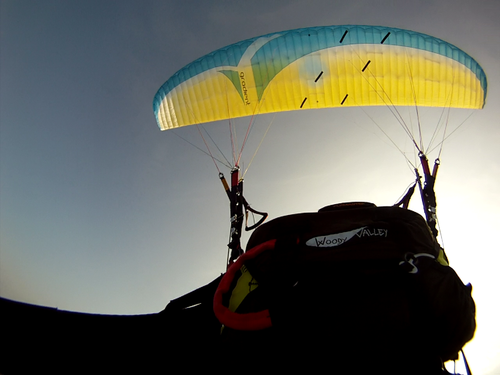Golden3 26 |
|||||||||||||||||||||||||||||||||||||||||||||||||||||||||||||||||||||||||||||||||||||||||||||||||||||||||||||||||||||||||||||||


|
|||||||||||||||||||||||||||||||||||||||||||||||||||||||||||||||||||||||||||||||||||||||||||||||||||||||||||||||||||||||||||||||
Instability rating |
|||||||||||||||||||||||||||||||||||||||||||||||||||||||||||||||||||||||||||||||||||||||||||||||||||||||||||||||||||||||||||||||
|
|||||||||||||||||||||||||||||||||||||||||||||||||||||||||||||||||||||||||||||||||||||||||||||||||||||||||||||||||||||||||||||||
Glider characteristics |
|||||||||||||||||||||||||||||||||||||||||||||||||||||||||||||||||||||||||||||||||||||||||||||||||||||||||||||||||||||||||||||||
|
Launch preparations: difficult
launch characteristics: dynamic, climbs constantly, no guidance necessary, good feedback during inflation, overshoots, pronounced braking required, accelerates before zenith, control check simple, low takeoff speed
asymmetric collapse: canopy colllapses at high angle to leading edge, moderate dynamics, total course change 270-360°, (4), fast course change rate, moderate forward pitching 45-60°, (2), very high height loss 50-59 m, (4), high sink velocity 20-24 m/s, (3), G-Force 2,5- 2,9 G, (2)
Frontal collapse: canopy collapses with low total collapse area, moderate pitch backwards 30-45°, moderate pitch forwards 30-45°, moderate dynamics, course change <90°, (2), variable recovery behaviour, at times immediate, at times delayed, automatic recovery, (3), usually symmetric recovery, simple pilot action required, (4), horseshoe, wingtips at front, delayed return to normal airspeed, marked deep stall phase, high height loss 40-49 m, (3), moderate sink velocity 15-19 m/s, (2)
Spiral dives: rapid sink velocity increase, Moderate G-Force 3,5- 4.0 G, (2), Sink velocity after 720° <18 m/s, (3), Moderate maximum sink velocity < 18 m/s, (2), sink velocity increase < 3 m/s on brake release, (1), Course change 180-360° after spiral exit, (2), moderate height loss during recovery 30-60 m, (2)
B-Stall: normal force required, marked pitch backwards 30-45°, marked pitch forwards 30-45°, stable sink phase, no tendency to deform, immediate return to normal airspeed, 6-8 m/s, height loss on recovery 20-40 m
big ears: simple initiation, stable flight phase, immediate automatic recovery, Vsink unaccelerated 2,5-3 m/s, Vsink accelerated 4-4,5 m/s, Vunaccelerated 0-3 km/h less than trimspeed, Vaccelerated >8 km/h faster than trimspeed |
|||||||||||||||||||||||||||||||||||||||||||||||||||||||||||||||||||||||||||||||||||||||||||||||||||||||||||||||||||||||||||||||
Notes |
|||||||||||||||||||||||||||||||||||||||||||||||||||||||||||||||||||||||||||||||||||||||||||||||||||||||||||||||||||||||||||||||
|
Launch preparations: On gliders where thin, unsheathed gallery lines are present (Nova Mentor 2, Swing Mistral 6, Ozone Rush 3, Gradient Golden 3, Skywalk Chili 2, Nova Ion Light) line checks become increasingly demanding. Launch characteristics: The Nova Mentor 2, Skywalk Chili 2 and Golden 3 from Gradient were all somewhat tamer, but giving these gliders too much of an impulse or leaving your hands on the A-risers for a little too long would make them all clearly overshoot. Frontal Collapses: Normal-speed symmetric recovery” from a massive frontal collapse as demonstrated by e.g. Nova Ion Light and Prion, Skywalk Mescal 3 and Gradient 4, are the least challenging for the hobby-pilot. A significantly delayed recovery, or the tendency to horseshoe require much better pilot skills to manage safely, and are always associated with greater loss of height. |
|||||||||||||||||||||||||||||||||||||||||||||||||||||||||||||||||||||||||||||||||||||||||||||||||||||||||||||||||||||||||||||||
Rating |
|||||||||||||||||||||||||||||||||||||||||||||||||||||||||||||||||||||||||||||||||||||||||||||||||||||||||||||||||||||||||||||||
|
Safety class 4 This class of paraglider reacts demandingly to one or more of the following manoeuvres: frontal collapse, asymmetric collapse or spiral dive.Demandingly means that the above manoeuvres result in marked dynamic reactions from the glider and/or large height losses. Advanced piloting skills which need to be regularly practised, together with good personal reaction times are required to safely fly this class of gliders. Basic recovery techniques for ending a manoeuvre are not sufficient to maintain control, reduce height loss to a minimum and prevent subsequent critical reactions. Pilots should be able to recognise the onset of the above manoeuvres and be able to prevent or minimise their effects through immediate and precise pilot inputs. Additional experience such as regular ground handling and SIV training is required to safely fly gliders of this class. Special training or pilot skills which exceed standard training may be required for the safe performance of emergency descent techniques. Gliders of this Safety Class are not suitable for beginners, irregular flyers or low-airtime pilots. |
|||||||||||||||||||||||||||||||||||||||||||||||||||||||||||||||||||||||||||||||||||||||||||||||||||||||||||||||||||||||||||||||

